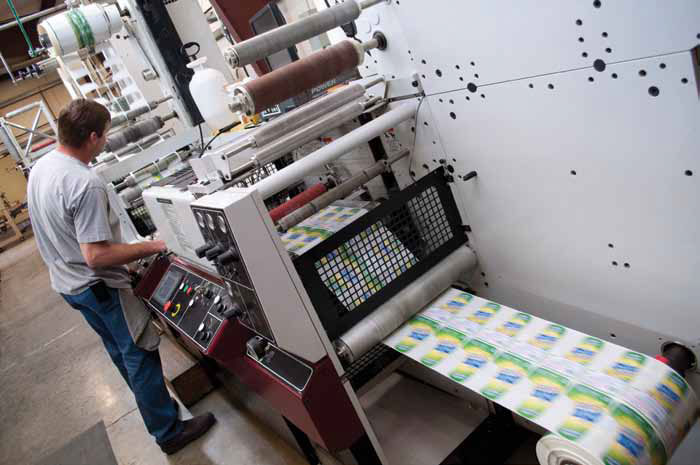
Revolution Labels Ensures a Common Visual Match To Offset with G7 Master Program
By Catherine Haynes
(This article orinally appeared in FLEXO Magazine, April 2011 issue. Used with permission.)
Like many who have taken detours in business that eventually lead to success, Mike Spillers, president of Revolution Labels in Spartanburg, S.C. didn't get into flexography by design. In fact, it wasn't even his idea. As owner of a thriving offset printing business, he was asked a few years ago to go into the flexo business by a major customer.
"At the time, I knew that one of my biggest customers was steering some business toward flexography, but I had no interest in launching a new printing endeavor," says Spillers. "When the firm could not find a flexo printer that met its high standards, that convinced me to jump in."
"Jump in" is an understatement. He made a significant capital investment in premium flexographic technology-a Mark Andy 3000, 13-inch, 10-color press-that would impress even much more established flexo printers. With a dogged commitment to highly precise proof matching and printing of brand images, Spillers also set out to acquire the International Digital Enterprise Alliance (IDEAlliance) G7 Master qualification, a designation that very few flexographic printers hold today.
Solid Match: Press to Proof
- G7 suppliers adhere to key metrics with the goal of reliably rendering brand images across print locations and different printing processes.
- Modern application of gray balance is based on colorimetry and employs process controls.
- G7 provides invariable, empirical and quantifiable data that says to customers and print buyers, "Yes, we can achieve a common visual offset match of brand images and other print output."
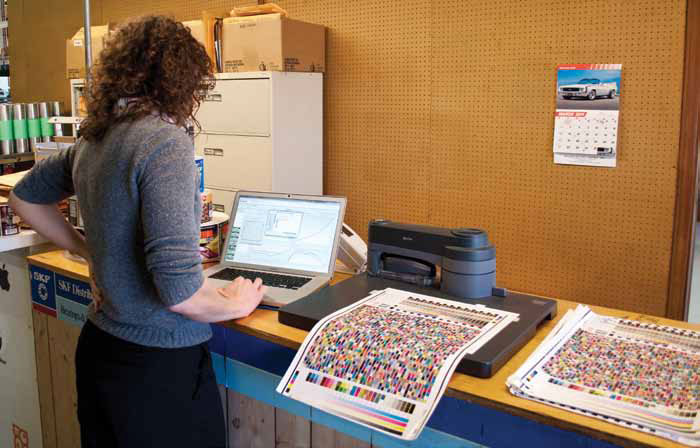
The author takes measurements with a spectrophotometer, then documents results, using all-important control targets.
RAISING THE BAR
Although well-known and recognized within the offset printing industry, the G7 Master Program has less of a following in flexographic circles, something IDEAlliance is trying to change. According to IDEAlliance, G7 companies are trained to proof or print to G7 Neutral Print Density Curves. Print buyers can expect G7 suppliers to adhere to key metrics with the goal of reliably rendering brand images across print locations and different printing types. The qualification mark means that the printer uses this modern application of gray balance that is based on colorimetry and employs G7 process controls.
"The benefit of G7 for the flexo printer is that they are able to gray-balance the imagery and address the customer's particular needs," says Joe Fazzi, vice president, media production technologies at IDEAlliance. "Flexo printing requires a lot of custom ICC profiles because of the inks and substrates, so having it gray-balanced with specific targets is very helpful to the printer to be able to proof to it and know with certainty what the product is going to look like. Print buyers like G7 because consistent brand recognition is critical. They know they can move from offset to point-of-purchase displays to banners or other products and have some assurance that the brand image looks like it is intended to."
Revolution Labels shares some of the same customers as an offset printing partner that was already G7-qualified, so there was an expectation that Revolution Labels would adhere to the same standards, and that proofs and sharing of jobs would go seamlessly. Plus, because so few flexographic printers are G7 Master-qualified, having this designation gives Revolution Labels a competitive edge.
"The fundamental controls required by G7 help make sure that products sitting side-by-side on the shelves visually match," says Spillers. "For example, one of our customers is a major food company with a mayonnaise product. The 32-ounce jar has an offset label, while the 48-ounce jar displays our flexo label. Obviously, the two labels have to look the same to the consumer. The G7 process that All Printing Resources (APR) helped us put in place gives us the tools to hit the offset bull's-eye every time."
GETTING TO G7
As the southeastern technical solutions manager for APR and a G7 Expert, as designated by IDEAlliance, I was in a unique position to try and help Revolution Labels become part of the small-but growing-family of flexographic printers with G7 Master status.
After an initial consultation with Mike Spillers, we determined that the best approach was to schedule a 2- to 3-day onsite engagement. Our goal was to complete a thorough analysis of current capabilities, validate that the process was repeatable, and then print the proof-to-press (P2P) target and make adjustments to calibrate Revolution's process. The pre- and post-G7 samples could then be submitted to IDEAlliance for review. The entire process lasted about 3 weeks, which included ample time for the IDEAlliance G7 staff to review the proof and print submissions and supporting data properly. However, the first few days were critical in determining consistency, baseline measurements and adjustments that needed to be made to gray-balance their process.
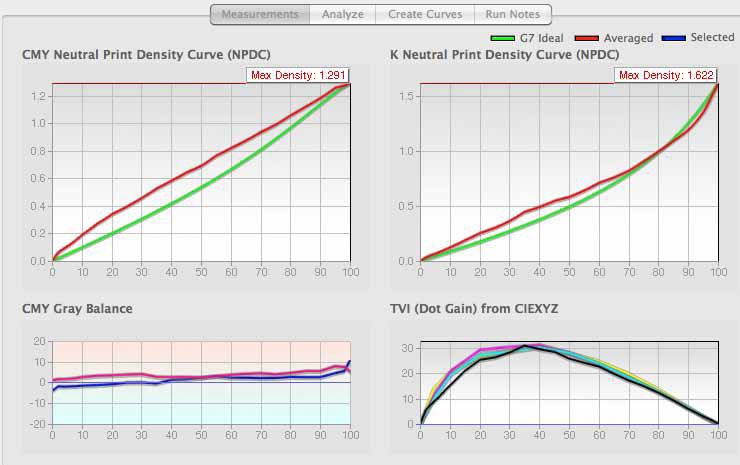
Figure 1. Screen capture of IDEAlliance Curve2 software analysis of the linear P2P target. The NPDC curve is based on measurements from several print samples and is slightly higher than the target NPDC curve. However, the CMY gray-balance curves indicate their process has a natural gray balance.
Although the specific road to a G7 Master qualification is somewhat different for every printer, the process for Revolution Labels was fairly straightforward:
- Consistency check: The first step was to establish a baseline status by running a series of live jobs without any tweaking to check for consistency in printing.
- Measurement analysis: Using pressroom print analysis tools and software, spectral and density data was analyzed onsite and a correction curve was created. (See Figure 1.)
- Graphic file adjustments: Based on the correction curve, the art files and plates were adjusted to more closely align with the target color space.
- Validation run: With the changes applied, a second run was conducted to validate the modifications; remarkably, the Revolution Labels team was successful with only the two runs. (See Figure 2.)
- Submission and Review: The correction curve and samples were submitted to IDEAlliance for review; Revolution Labels received a G7 Master qualification on their first attempt.
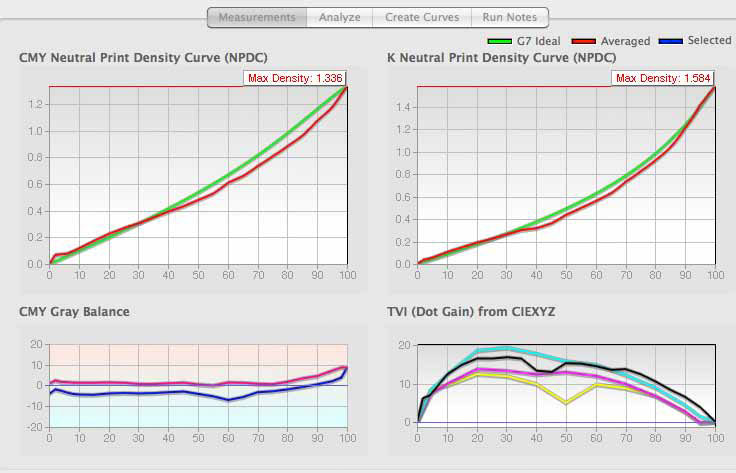
Figure 2. Screen capture IDEAlliance Curve2 software analysis of the G7 P2P target. The NPDC curve is based on measurements from several print samples. While the CMY NPDC curves could be further refined to more closely match the target NPDC curve, we came fairly close with the first adjustment.
"It was a very hands-on process and well worth it," says Spillers. "From the beginning, we could see how close we were to theoretical perfection in terms of being a solid match, press to proof. We ran through a standard density test and really didn't do anything to make our flexographic job align with G7 requirements, but the good news was that we were very close, right off the bat."
The first few baseline runs did indeed show that Revolution Labels was already very close to meeting G7 requirements. Using the data from the measurement software, I worked closely with the offsite prepress group to create a set of correction curves. Once we had the G7 corrected plates, Revolution's pressroom was able to reprint the P2P target, and we were able to validate a much closer match to our target color space.
"When it comes to the G7 Master qualification process for flexographic printers, there are some unique challenges," says Joe Fazzi of IDEAlliance. "For example, when we look at the pass/fail requirements in passing gray-balance tests, we have to look at the highlight areas as they are applied differently than for other types of printing processes. That's more about the mechanical nature of flexography. But it's an evolving process and we're continually having our people take a look at how we can improve and refine the G7 Master qualification process for flexographic printers."
What G7 Means to Flexo graphic Printers
The G7 Master Program has been around a long time in the offset industry and has developed acceptance and notoriety among printers. But the same can't be said for its presence in flexography, although there are clearly some significant benefits. Of course, G7 targets have to be achievable and practical for flexographic printers to get on the bandwagon and, unfortunately, there may be some misinformation and skepticism among flexographic printers about whether it will help their business.
In the past, one main challenge for flexographic printers has been to try and hit IDEAlliance G7 targets and requirements. This has in part led to additional advancements and improvements to the process itself, as well as related technology, tools and software available to both prepress and the pressroom. Combined with the higher consumer product company demand for flexo-printed products to match that of their offset counterparts (especially when they sit next to each other on a store shelf), the onus is on our industry to meet that demand.
Getting G7 Master Program qualification has helped Revolution Labels:
- Ensure a common visual match to offset output.
- Put a defined, measurable and repeatable pressroom process in place.
- Reduce the possibility of errors and the costs associated with them.
- Gain a competitive edge.
What G7 Means to Flexo graphic Printers
What G7 means for today's flexographic printer is that you now have a better definition of your customers' expectations, how they define gray and their target color space. This benefits you, the printer, both internally amongst all your print devices, and for those with multiple locations or multiple print processes. Of course, the exact definition and targets that constitute gray balance are at the core of the G7 Master Program. By defining a common gray, we establish a baseline for all other colors so all G7 print devices are shooting for the same bull's-eye.
A second benefit is that, once the G7 protocol is in place, it becomes a good tool to calibrate the process and print more consistently from run to run. It's essential for the pressroom manager to help make sure the last roll looks like the first roll off the press, which looks like the previous run for that product. Maintaining this kind of quality control can be very challenging without reference targets. In fact, without them, the press calibration process is really an act of futility.
Invariable, Emperical, Quantifiable
Although the decision by Revolution Labels to become G7 Master-qualified was driven primarily by the needs of one of its top customers, the printer already had an appreciation for the benefits of calibrating equipment for proper gray balance and having measurable targets to control the process.
G7 Step-by-Step
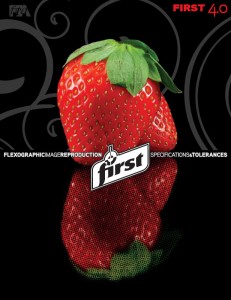
Flexographic Image Reproduction specifications and Tolerances (FIRST) supports near-neutral calibration (G7) as a concept. As such, it documents five steps in a near-neutral calibration approach to process color separations. Printers and prepress technicians should:
- Specify a mono-pigmented CMYK ink set. (See table for FIRST recommendations.)
- Print a gray-balance/near-neutral calibration target to collect the data necessary for near-neutral calibration. Make sure to print the target using the selected ink set under standard operating conditions.
- Evaluate multiple samples. Use data collected from spectrophotometers on solid ink density, dot gain, print contrast, L*a*b values, etc.
- Apply the near-neutral calibration print curves to the image, instead of traditional dot gain curves.
- Run the press under the same conditions as the near-neutral calibration test target was printed. Use a control target to monitor and regulate density, dot gain, trap, print contrast and ink color.
| FIRST Recommended Process Ink Pigments Reference Print Section 21.2.2 |
|||||||
|---|---|---|---|---|---|---|---|
| Color | Chemistry | C.I. | Ref | L *a *b | C | h | ° |
| Yellow | Solvent | Y14 | 90 | -4 | 111 | 111 | 92° |
| Water | Y14 | 92 | -6 | 101 | 101 | 93° | |
| UV | Y13 | 92 | -5 | 83 | 83 | 93° | |
| Magenta | Solvent | R57:1 & R52:1 |
46 | 72 | 9 | 72 | 7° |
| Water | 53 | 70 | -4 | 70 | 357° | ||
| UV | 50 | 76 | -1 | 76 | 359° | ||
| Cyan | Solvent | B15:3 & B15:4 |
56 | -41 | -47 | 62 | 229° |
| Water | 59 | -37 | -45 | 59 | 230° | ||
| UV | 56 | -38 | -45 | 59 | 230° | ||
| Black | Solvent | K7 | 21 | 1 | 3 | 3 | -na- |
| Water | 16 | 0.8 | 1 | 1 | -na- | ||
| UV | 16 | 0.2 | 5 | 5 | -na- | ||
"Having come from an offset background, G7 was almost a requirement," says Spillers. "Now that I've been in the flexographic business for a while, it's just as important to me as it ever was in offset. Granted, the challenges are different than the ones faced in offset, but flexography has improved so much in recent years, with much better technology, plates and presses. We are absolutely committed to ensuring the integrity of the brand's visual identity when customers trust Revolution Labels to produce their packaging. That is the very essence of our success."
"Brand owners are asking for [G7]," says Fazzi, who notes that IDEAlliance has never done a major G7 marketing campaign. "It's been more of a grassroots movement. When brand owners make a major buy, they demand consistency across product banners, point-of-purchase displays, wraps, signage and products. It's all about brand recognition, so G7 helps maintain some consistency and color fidelity across all these different print processes and across all these different types of substrates."
For Mike Spillers, it's all about the data, what it means to his customers and how it helps him compete. "G7 provides invariable, empirical and quantifiable data that says to customers and print buyers, 'Yes, we can achieve a common visual offset match of brand images and other print output.' You can't deny that's a competitive advantage."
About the Author: Catherine Haynes is a member of the Technical Solutions Group for All Printing Resources. She has more than 15 years of experience in the printing industry and has been a certified G7 Expert for more than 2 years. At present, Haynes chairs FLEXO Magazine's Editorial Advisory Committee. For more information, contact her using our online Training Info Request Form.
Download a PDF of the original FLEXO Magazine article - FLEXO_APR_G7_April_2011.pdf 1.2 MB.
